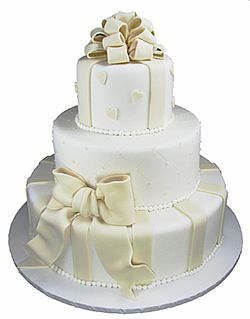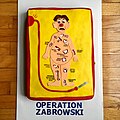 Wedding cake covered and decorated with fondant | |
| Type | Confectionery |
|---|---|
| Place of origin | France |
| Main ingredients | Poured fondant:
sugar,
water,
gelatin,
glycerine Rolled fondant: sugar, water, gelatin or agar, food-grade glycerine |
Fondant icing, also commonly called simply fondant ( /ˈfɒndənt/, French: [fɔ̃dɑ̃] ⓘ; French for 'melting'), is an icing used to decorate or sculpt cakes and pastries. It is made from sugar, water, gelatin, vegetable oil or shortening, and glycerol. [1] It does not have the texture of most icings; rolled fondant is akin to modelling clay, [2] while poured fondant is a thick liquid. The flavor is generally considered a weak point, as it is sweet and chalky. [3] It is generally chosen for its appearance rather than the way it tastes. [4]
The word, in French, means 'melting,' coming from the same root as fondue and foundry.
Rolled fondant
Rolled fondant, fondant icing, or pettinice, which is not the same material as poured fondant, is commonly used to decorate wedding cakes. Although wedding cakes are traditionally made with marzipan or royal icing, fondant is increasingly common due to nut allergies, as it does not require almond meal. Rolled fondant includes gelatin (or agar in vegetarian recipes) and food-grade glycerine, which keeps the sugar pliable and creates a dough-like consistency. Rolled fondant is rolled out like a pie crust and used to cover the cake. The result is a perfectly smooth surface that is well-suited for aesthetic expression, especially for complex shapes, such as large ruffles, that would be difficult to make with a softer icing. [2] [4] It also takes food coloring well. [3]
Rolled fondant is very sweet but otherwise is not considered to taste good or to have an appealing texture. [2] [4] Some bakers who use it recommend against eating it. [2] [4]
Alternatives to rolled fondant include marzipan and mochi. [3]
Types include:
- Ready-made rolled fondant
- Commercial, shelf-stable, pre-made rolled fondant often consists principally of sugar and hydrogenated oil. However, different formulations for commercial shelf-stable fondant are available and include other ingredients, such as sugar, cellulose gum, and water.
- Marshmallow fondant
- Marshmallow fondant [5] is a form of rolled fondant often made and used by home bakers and hobbyists. Marshmallow fondant is made by combining melted shelf-stable marshmallows, water, powdered sugar, and solid vegetable shortening. Home bakers use this recipe for homemade fondant due to the readily available access to required ingredients. [6]
- Sculpting fondant
- Sculpting fondant is similar to rolled fondant but with a stiffer consistency, which makes it a good sculpting material.
- Sugar paste
- Sugar paste, also called gum paste, is similar to rolled fondant, but hardens completely—and therefore is used for bigger cake decorations, such as bride and groom figures, bigger flowers, etc. Sugar paste is made mainly of egg whites, powdered sugar, and shortening. [7] Tylose can be added to make gum paste more pliable for detailed work. [8]
Gallery
-
Cake covered with chocolate rolled fondant
-
A fondant-covered cake depicting a sewing kit
-
Fondant-covered cake with flowers
-
Red fondant on a Valentine's Day cake
-
Fondant in the shape of eggs
-
" Operation" cake made of fondant
See also
References
- ^ "How to Make Rolled Fondant (Bold Baking Basics)". Gemma's Bigger Bolder Baking. 1 August 2016. Retrieved 2017-10-15.
- ^ a b c d Eby, Margaret. "How Fondant Became Reddit's Enemy". Food & Wine. Retrieved 2024-02-16.
- ^ a b c Poll, Zoey (15 February 2024). "Give Fondant a Chance". The New York Times.
- ^ a b c d Matte, Lisa Curran (2023-01-12). "Why Is Fondant So Polarizing?". Tasting Table. Retrieved 2024-02-16.
- ^ "Rolled Marshmallow Fondant". www.wilton.com. Retrieved 2018-06-04.
- ^ "My big fat British wedding cake". BBC. 8 October 2015. Retrieved 16 October 2015.
- ^ "Fondant vs Gum Paste vs Modeling Chocolate". myblueprint.com. Archived from the original on 28 May 2020. Retrieved 30 March 2019.
- ^ "Tylose gumpaste recipe tutorial". designmeacake.com. Retrieved 31 March 2019.






